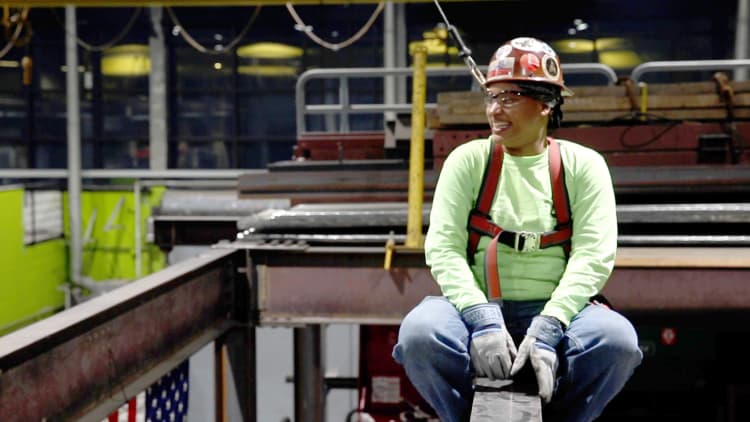Memesha Davis is a Brooklyn native, a mother of two and a structural ironworker — a job that she says has changed her life.
"Prior to ironwork, I had every job that you could possibly think of: customer service, retail, hostess. And nothing ever fulfilled what it is that I wanted to do, so I've always tried to fill the void of not working in a trade or work with my hands," she says. "I was not happy with that work and I was making absolutely nothing."
In 2015, Davis was a hostess at the Barclays Center's 40/40 Club and was also working at her aunt's restaurant. She says her hours were limited and inconsistent, and without benefits, she relied on Medicaid and food stamps to support her family.
"The year that I was working at the Barclays Center and with my aunt, I made maybe $13,000 for the year," she says. "At the time, my son was 6, my daughter was 7. Raising kids on that budget was painful because there will be times where they just want something that costs a dollar, but a dollar was like a stretch."
She continues, "It was just like a look of just disappointment on their faces, and being a single mom and trying to provide for your children as best as you can, it takes a toll on you daily."
This year, Davis expects to make over $100,000 as a union ironworker journeyman.
Getting the job
A graduate of William E. Grady Career and Technical Education High School, Davis says she has wanted to work in a trade field since she was a teen, but felt pressured to take her high school's culinary arts program.
"As a 14-year-old, a teenager, a young girl, I was told that I wouldn't be able to make it in that field, so I ended up switching from HVAC into culinary arts cooking," she says. "And that wasn't my passion."
Years later, Davis was introduced to ironwork through Nontraditional Employment for Women (NEW) — a New York-based organization that prepares, trains and places women in careers in skilled construction, utility and maintenance trades.
She chose to enroll in NEW's free 7-week training program in 2015, noting that they also provided her with a generous, but ultimately essential, free metro card that allowed her to get to and from classes. "At first, I thought it was a bribe," she says with a laugh.
"NEW was definitely a life-changer. It gave me back my confidence and like I went from 'I can't' to 'I know I can,'" recalls Davis. "They saw a potential in me and they guided me into being more than just a hostess."
After completing NEW's program, Davis took a tour of the New York Ironworker Union's training facility in Astoria, Queens. She was immediately hooked.
"I remember coming to the school and taking a tour and I was like, 'Oh, my God! This is this for me,' because I'm an adrenaline junkie," she says, describing the large warehouse-like 12,000-square-foot workshop that apprentice ironworkers are trained in. "You see this big column, you see a replica of what a building will look like in the field, you have these torch booths, you have the welding booths."
On top of that, "the apprenticeship program for ironwork didn't cost anything."
The union's apprenticeship program lasts three years and involves two to three days per week of classes and on-the-job training. Apprentices earn upwards of $38 per hour, are walked through necessary credentials and receive health benefits.
Those benefits proved to be crucial for Davis who was diagnosed with stage 1 cervical cancer in 2016. She says that the union president and the apprenticeship program supported her and gave her flexibility while she underwent chemo.
"I remember just breaking down and crying at that moment and my general foreman, my shop steward, my foreman, all these guys were like, 'Whatever you need, we're here for you,'" she says. "This is like a family that I never thought I would have."
Davis has been cancer-free since February 2018 and graduated from apprentice to journeyman in September of 2020.
"The difference from being an apprentice, to journeyman, is drastic," she says. "As an apprentice, you can make anywhere from $100,000 a year to $120,000. As a journeyman, you can make anywhere from $120,000 plus."
Bryan Brady, the director of training at Davis' union says that on average, apprentices make $58,000 per year and journeymen make $108,000 per year, but notes that it is entirely possible to make the totals that Davis mentions by working overtime.
"It all depends on the amount of work available, the weather and the workers' ability to stay healthy," he says. "If a worker gets rained out or is sick and misses a day of work, they receive no pay."
A day on the job
"A normal day on the job is first me trying to convince myself to get out of bed, especially when it's cold outside," says Davis, who is currently working as part of a detail "gang" for the construction of a skyscraper in the Manhattan real estate development project, Hudson Yards.
She says her commute from Brooklyn to Manhattan takes roughly 40 minutes. She arrives to work around 6:30 a.m., and a hoist lifts workers to the building's upper levels around 7:00 a.m.
By 7:30 a.m., Davis and her team are hard at work. She says their tasks change daily.
"We never do the same thing every day," she says. "Today, for instance, it was windy and we had to bring a torch upstairs — a bottle of oxygen and a bottle of acetylene. And then we had to cut pieces out [of the steel frame] so that the plumbers and steamfitters can put their pipes through certain holes."
The ironworkers get a quick coffee break around 10:30 a.m., followed by a lunch break around noon, she says, describing how a manlift carries the crew from floor to floor while they are "burning."
"We wrap up around 3:00 so we can catch the hoist to go downstairs and make sure that everything is put away and we leave around 3:30 p.m.," says Davis.
The weather is typically the hardest part of the job, she says, explaining how the wind and cold can make dangerous conditions worse.
"A breath of fresh air"
Ultimately, Davis says she wishes she had pursued ironworking sooner.
"This has definitely given me a breath of fresh air because going from $15 an hour, maybe eight hours a week, to actually having some type of consistency, definitely changed everything for me," she says. "To go from $13,000 a year to $100K a year, it's a drastic change. And there's also, the benefits that I receive from ironwork — the health benefits. Now, I have a pension to look forward to when I retire. They have a scholarship fund for my kids."
Beyond pay and benefits, Davis says the transition has made her happier.
"There's a huge difference from when I was working and I really wasn't happy, just trying to make ends meet, to now where I have stability. Now, I'm able to do things that I never thought I'll be able to do, even just a vacation, even just to go one state over. It makes a huge difference," she explains.
Davis adds that working on skyscrapers that will add to the New York skyline for decades to come gives her a sense of pride, describing how she felt helping build One Vanderbilt, a 67-floor skyscraper in midtown Manhattan.
"I remember working at One Vanderbilt and looking across the way and seeing the Chrysler building. And I'm like, 'Wow, I'm making history, but I'm also looking at history," she says. "There's a lot of guys that I work with, their grandfather did it, and I'm like, 'You're amazing! You were just made for this,' but I'm the first one in my family to ever do anything in this field as far as any trade."
She adds, "I feel like I'm making history of my own."
Do you have a creative or nontraditional career path? We'd love to hear from you! Fill out this form to be considered for a future episode of "On the Job."
Don't miss:




